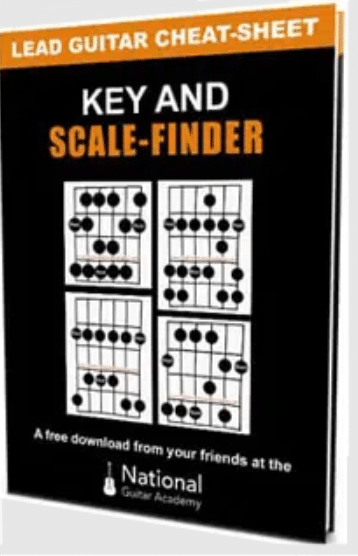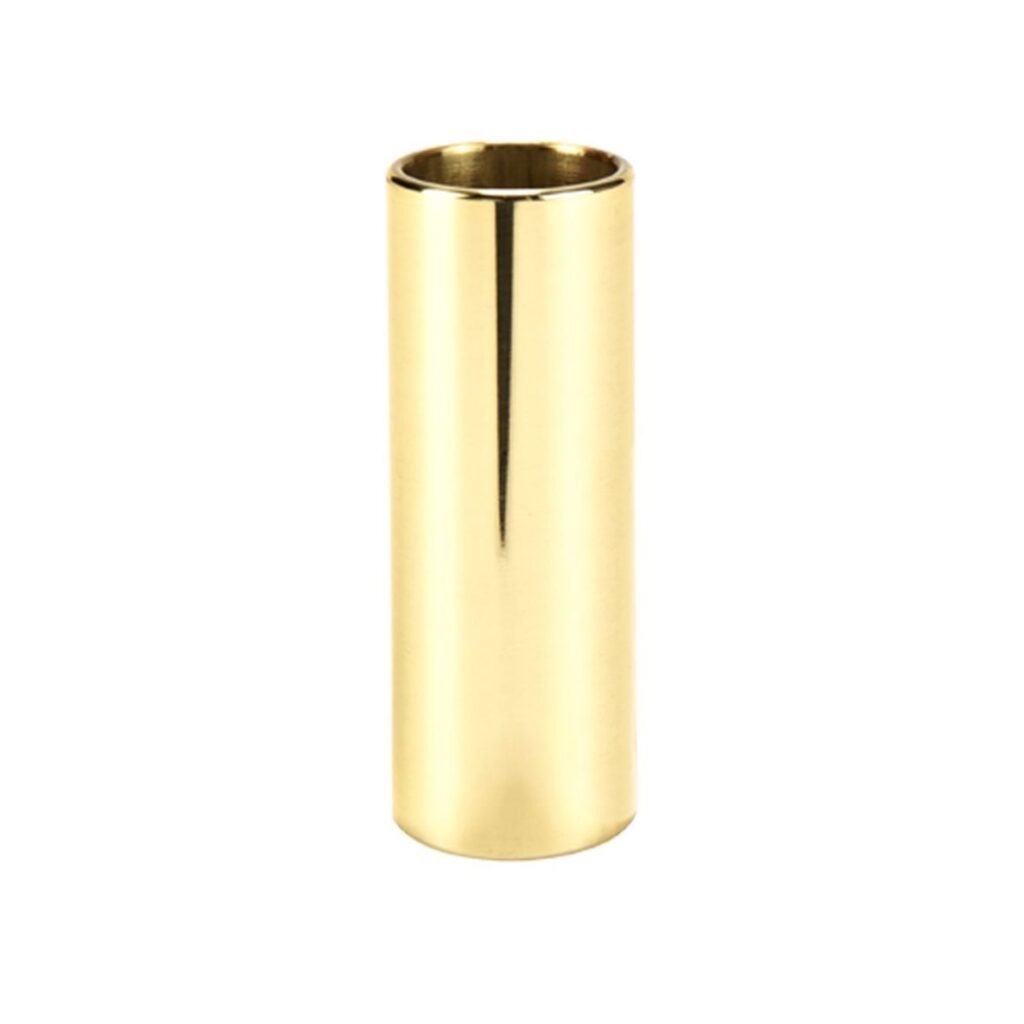Slide guitar tuning seems complicated but it’s actually pretty simple. In this guide we’ll show you 6 essential slide guitar tunings that will make you sound amazing.
In this free guitar lesson you will learn:
- 6 epic slide guitar tunings that will turn you into a slide monster.
- 4 quick & easy tips that will transform your slide playing.
- 10 must-know slide guitarists that will blow your mind.
Over 100,000 guitar-learners get our world-class guitar tips & tutorials sent straight to their inbox:
Click here to join them
Get our best guitar tips & videos
Slide guitar tuning is pretty straightforward…
The most popular style of slide guitar originated with the Mississippi Delta Blues, which came to Chicago and met the electric guitar, and that combination has been influencing music worldwide ever since.
This guide will explain the different slide guitar tuning options, you can add to your guitar toolbox.
An important caveat about slide guitar tuning
Slide guitar is not, at its essence, about which tuning you use. You can use standard tuning or you can create any tuning that sounds good to you, apply a slide, and you are ‘in’ slide guitar tuning.
- So there isn’t an official or ‘proper’ tuning to use when playing slide guitar. Even so, we’ll share the most common slide guitar tunings with you.
- But it’s important you know that ‘slide guitar’ is more about the sound characteristics rather than pitch or tunings.
It’s a way for you to be more creative on the guitar and there’s lots of room for exploration. (And there is always room for Lowell George…)
Our recommendation for a great starter slide
The Dunlop 222 Brass Slide is a fantastic piece of kit that we think every guitarist should own. It sits neatly on the hand without too much movement, and it feels great to play with!
The most common slide guitar tuning: Open G
You probably already know that generally when you tune your guitar, you tune it to standard tuning. The notes on the strings are E A D G B E.
- One aspect of standard tuning is that the D, G, and B strings, when played together without any additional strings, make up a G major chord. For this reason, getting to the most popular tuning, open G, is pretty simple.
- To get to open G, you tune both E strings down a whole step so they become Ds. Tune your A string down a whole step so it becomes a D. Just like that, you are in open G tuning. The notes on the strings now are D G D G B D.
When you strum your guitar, the whole thing sounds like a nice clean G major chord without you having to fret any of the strings, which is why it is called ‘open tuning’.
The beauty of open tuning, and the reason it is so useful for slide guitar, is that now, no matter where you place the slide, you have an open chord.
Here are some chords to try in combination with the open strings:
Open G tuning is sometimes called Spanish tuning because of its role in shaping the slack key style in Hawaiian guitar; European traders first introduced the tuning to Hawaiian players.
- Open G is the most popular slack key tuning as well as a very common slide tuning.
- For more on Hawaiian slack key guitar, you can check out this extremely erudite and detailed piece by George Winston
- If you are using open G slide guitar tuning for blues purposes, you are in great company!
Everyone from Son House to Muddy Waters, to Waters’ protege Mike Bloomfield, to Rory Gallagher and Ry Cooder, who reportedly showed it to Keith Richards, has made open G tuning a major part of their playing style, and now it is also yours!
Check out this weird little Beefheart tune for a sample of Ry Cooder’s playing in open G:
Learn 12 EASY beginner chords with our popular guide
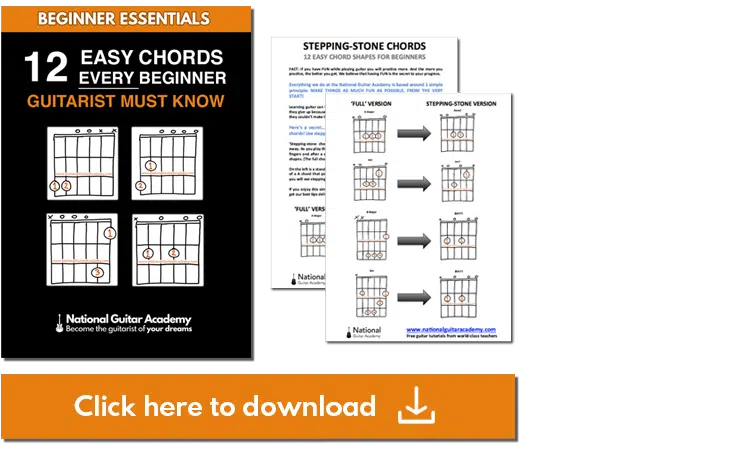
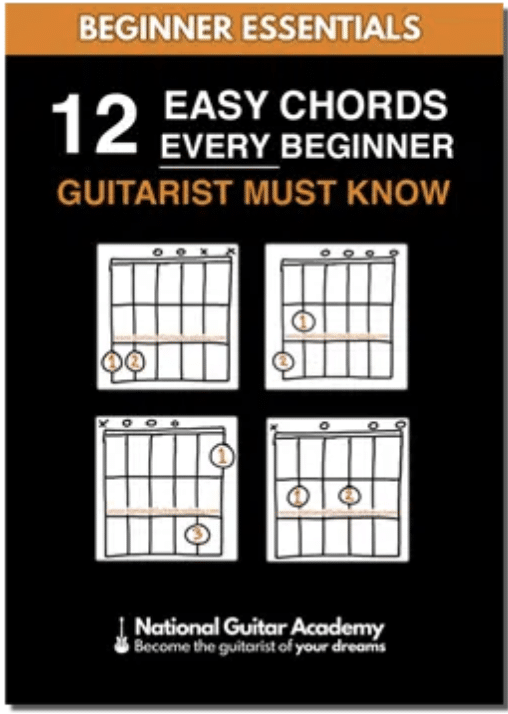
Where should we send it?
✅ Stop struggling. Start making music.
✅ Learn beginner-friendly versions of every chord.
This is our most popular guide and it will improve your chord ability quickly! 😎
Get your own personalised guitar-learning plan 🎸
Get a custom guitar-learning plan here: Click here for GuitarMetrics™
World-Class Guitar Courses 🌎
Learn from the world's best guitar educators: Click here for our guitar courses
Open G’s higher-strung sister, open A slide guitar tuning
If you have your guitar tuned to open G, there are two ways to get to open A: either tune every string on your guitar up a whole step or place your capo on your open G-tuned guitar. Simple as that.
If you are in standard tuning, you do the opposite of what you did to get to open G:
- Leave the E strings and the A string alone.
- Tune the D string up a whole step so it is an E.
- Tune the G string up a whole step so it is an A.
- Finally, tune the B string up a whole step so it is a C#.
Your strings are now A E A E C# E, and you are in open A slide guitar tuning!
Because open A is just open G ‘moved up’ a whole step, everything that works in open G works the same way in open A because the relationship between the strings is the same. (It’s all just a step higher.)
Here is a diagram of the tuning and chords in open A.
It is generally true that the higher the pitch on the guitar, the more energy you create. You can hear this when a guitar solo soars up past the 15th fret and the crowd goes bananas.
- It is also true that if you take whatever you are doing in open G and raise the pitch by playing it in open A, it will have more energy.
- Because open A has a direct relationship to open G, anyone who plays in open G can also play in open A. Here is an introductory lesson on playing in open A by Johnny Winter.
- Open A slide guitar tuning is used in Jimmy Page and the Black Crowes’ version of “In My Time of Dying.” You can easily play the intro to this song by using the above chart: work it out using the open strings and frets 2, 3, and 5, and at the end you get to slide all the way up to fret 12!
Another world-class guitarist who frequently uses open A slide guitar tuning is Bonnie Raitt. She used it, in fact, on one of her biggest hits:
Pro-tip: Different slide guitar players use different materials for their slides. There is glass, for the bottleneck style or the legendary Corocidin bottle used by Duane Allman, and there is ceramic, and there are a few different metal ones. They all produce slightly different tones and are all worth a try!
Slide guitar tuning of the masters: open E
For a slide guitar tuning with slightly different characteristics than open G or open A, you can try open E.
Here’s how to get your guitar into open E from standard tuning:
- Leave the E strings and the B string alone.
- Tune your A string up a whole step to get a B.
- Tune your D string up a whole step to get an E.
- Finally, tune your G string up a half step to get a G#.
Your strings in this open E tuning will be E B E G# B E.
You have now tuned your guitar to the open E chord you play in standard tuning, and when you play this tuning further up the fretboard with your slide, it will sound a bit like playing E-shaped barre chords.
Here is where the most useful fret locations are for chords in open E tuning.
A little bit of slide blues history
Open E slide guitar tuning came straight from Robert Johnson, and when it arrived in Chicago, Elmore James’ recordings in the 1950s set the standard for slide blues playing that has influenced every major slide blues player since.
It does not always happen that the energy of a live performance transfers to a studio recording, but this Elmore James recording of “The Sky Is Crying” is one of the earliest examples of blues that will melt your face.
Using open E slide guitar tuning today
Open E slide guitar tuning is second only to open G in popularity because of its frenetic tone and ease of playing on the low frets.
It was a mainstay of Duane Allman’s playing and is now Derek Trucks’ main slide tuning.
Todd Rundgren’s guitarist Jesse Gress has written extensively about Allman’s playing. Here is one of his articles from Guitar Player magazine, covering Allman’s open E slide tuning.
Download our lead guitar cheat-sheet to make things easier
It's hard to understand which scales work with which keys.
So we created a cheat-sheet! A key and scale-finder that you can use again and again.
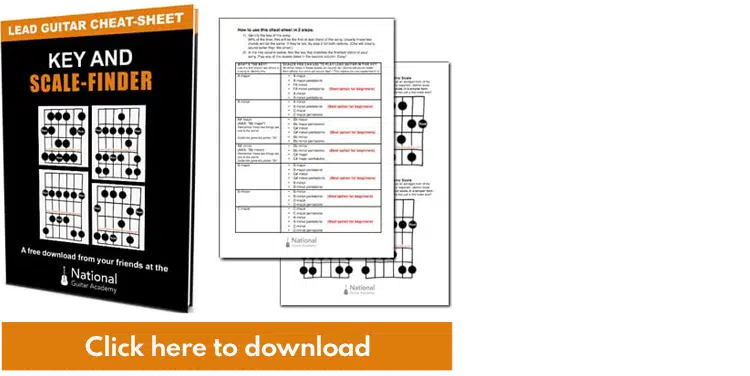
Get your personalised guitar-learning plan 🎸
Get a custom guitar-learning plan here: Click here for GuitarMetrics™
World-Class Guitar Courses 🌎
Learn from the world's best guitar educators: Click here for our guitar courses
Open E’s swampy little brother, open D slide guitar tuning
As open A is a companion to open G, open D is only two frets away from open E slide guitar tuning and has similar voicing characteristics.
To get from standard tuning to open D…
- Tune both E strings down a whole step to D.
- Leave the A and D strings alone.
- Tune the G string down a half step to F#.
- Tune the B string a whole step down to A.
You are now in open D slide guitar tuning.
In open D, your strings are D A D F# A D, making a D major chord. The open D slide guitar tuning gives your playing a bass boost with the low D string, and the resulting tone is swampy and deep.
Here is the rundown of tuning and chords in open D slide guitar tuning.
Open D is not limited to slide guitar and is sometimes referred to in country, folk, and blues music as Vestapol tuning, after a 19th-century song written about the Crimean war, “The Siege of Sevastopol.”
- For a demonstration of Vestapol tuning, here is your professor, Elizabeth Cotten, with “Vestapol.” Yes, she is playing upside down!
- If you like what you are working out while playing around in open E slide guitar tuning, using open D makes your strings a bit looser, so you can play the same riffs and rhythms and sound even more full on the low end.
Here is a great video by Nashville monster guitarist R.J. Ronquillo giving you some riffs in open D slide guitar tuning:
Standard tuning as slide guitar tuning
The different kinds of open slide guitar tuning discussed so far have a few things in common, the main one being that they are meant to make slide guitar easy.
However, a guitar does not have to be in open tuning to be playable with a slide.
Warren Haynes, who famously took over for Duane Allman when Dickey Betts reunited the Allman Brothers, began playing slide guitar in standard tuning because he had not yet learned that there was such a thing as open slide guitar tuning.
He discusses his learning process and the different slide guitar tuning options in this interview:
The main advantage of the standard tuning option is that you already know how to use it! You can take any melody that you’ve learned on the guitar and simply play it with a slide.
- To get the full effect of the slide and make your phrasing more interesting, try to find consecutive notes in the melody on the same string so you can slide up or down to them.
- The most prolific and awesome guitarist who used standard tuning as his main slide guitar tuning and who made it a defining characteristic of his style is George Harrison.
- He frequently doubled his slide guitar tracks to add texture and sometimes harmony, and the melodies he played up the neck with the slide frequently became the hooks of his songs.
“Isn’t It A Pity” is an understated and gorgeous slide guitar masterpiece, and he put it on “All Things Must Pass” twice, probably to make up for it not getting onto “Let It Be.”
Pro-tip: There are modifications you can make to a guitar to dedicate it to slide guitar playing, if you choose. The most common one is to install a higher nut to hold the strings further off of the neck. You can also try out your slide guitar skills on a resonator guitar, a dobro, a lap steel guitar, or if you are ready to dive down into slide guitar rabbit hole, a pedal steel guitar!
Further exploration in slide guitar tuning
We’ve covered the most common slide guitar tuning alternatives, but there is no reason to limit your options to the slide guitar tuning configurations everyone else uses for slide guitar.
There are other guitarists, like Joni Mitchell, Neil Young, Nick Drake, John Fahey, and Robert Fripp, who have used alternate tunings, sometimes including very interesting chord extensions. Try out your own and you might find your own unique slide guitar tuning.
Recommended resources
Here’s some more National Guitar Academy lessons you may enjoy:
5 Essential Slide Guitar Lessons For Intermediate Guitarists
Blues Guitar Lessons For Beginners – 4 Ways To Sound Awesome Quickly
How To Play Electric Guitar: A Beginner’s Guide
Major Scale Guitar – An Essential Guide For Lead Guitarists
Fingerstyle Guitar Lessons – 5 Easy Ways To Sound Amazing
What Type of Guitarist Are You?
Take our 60-second quiz & get your results: Take The Quiz
Join the world's best online guitar school 🌎
- Get your own personalised guitar learning plan (customised just for YOU).
- World-class online guitar courses. Learn at your own pace.
- Community Campus & Learning Forum - A friendly community! Connect with our team & students. 😊
- Beginner Song library with chordsheets, tabs and tips. (Songs suitable for all levels!)
- Regular live streams, seminars and Q&A sessions - Learn from world-class guitar educators. Get all your questions answered!
Click here to learn more about National Guitar Academy membership 
Cool Guitar T-shirts 😎
Look cooler! Check out our merch: Click here to see our merch store
Want free guitar tips and video lessons delivered to your inbox?
Join over 100,000 guitar-learners and subscribe to our guitar-tips-by-email service. (It's free.)
We'll send you a series of lessons that will move you to the next level of your guitar journey.
Learn how everything fits together quickly, easily and effectively. We share ninja tips (for instant fun!) but also timeless fundamentals that will deepen your understanding.


Get our best guitar tips & videos
Popular Lessons
How To Learn Guitar: An 11-Step Programme For Beginners
How To Choose The Perfect Beginner Guitar
More Cool Guitar Stuff
Learn about National Guitar Academy: About Us
Join us on Facebook for daily guitar tips.
Listen to our Learn Guitar Podcast for rapid guitar progress.
Check out our free chord lessons.


